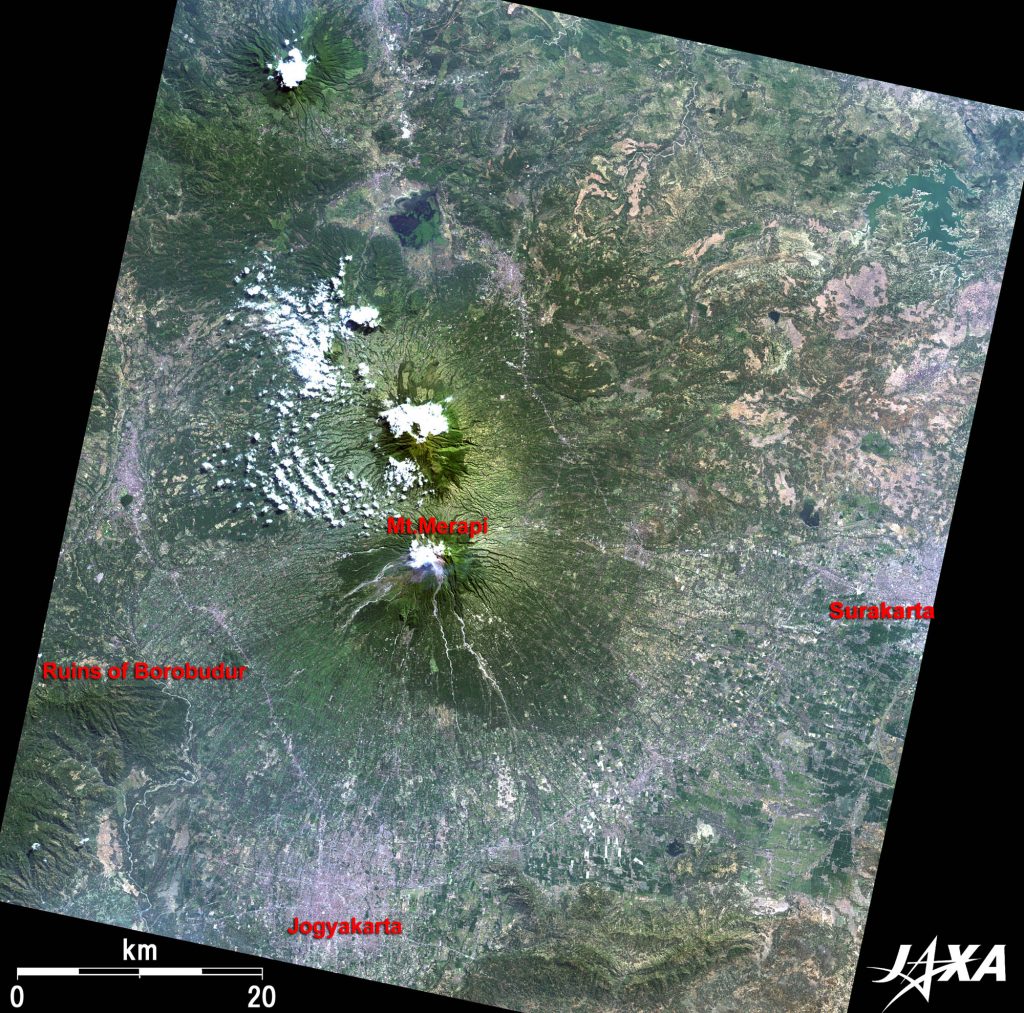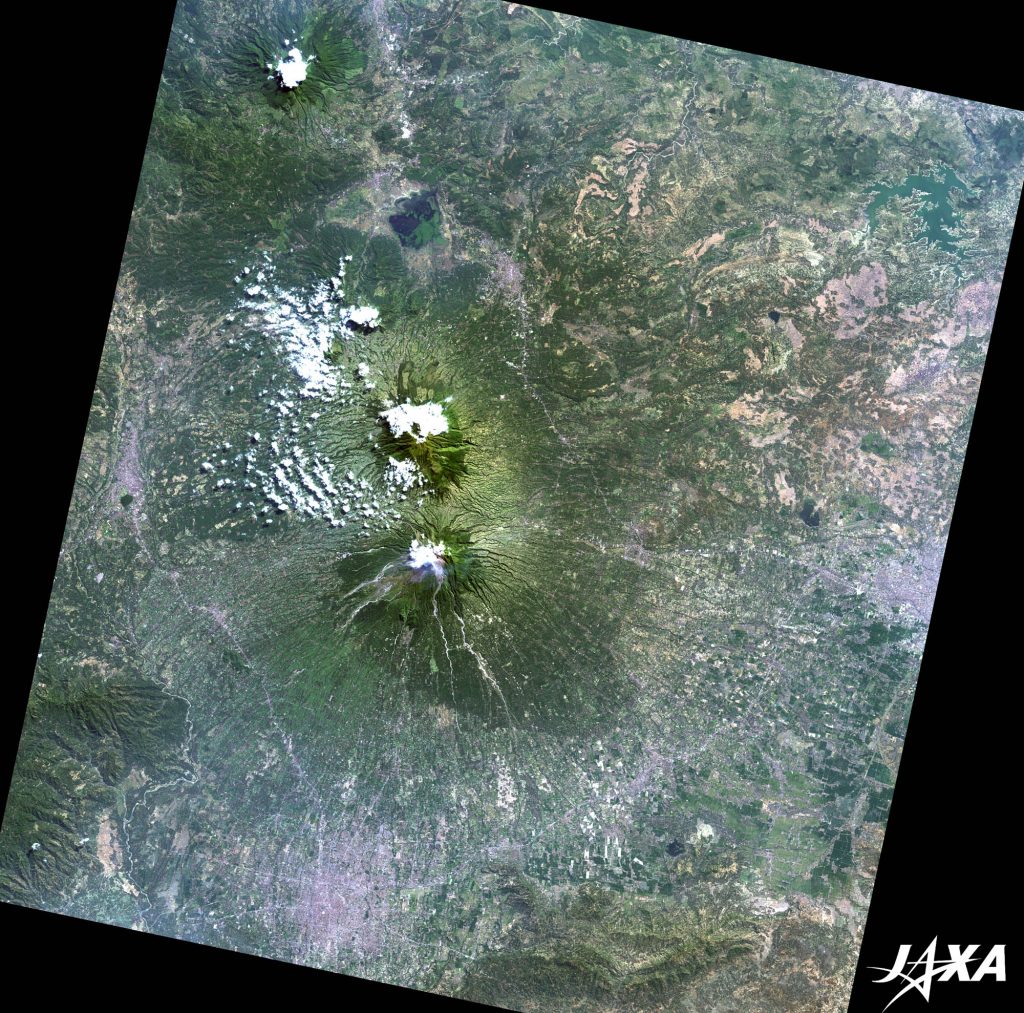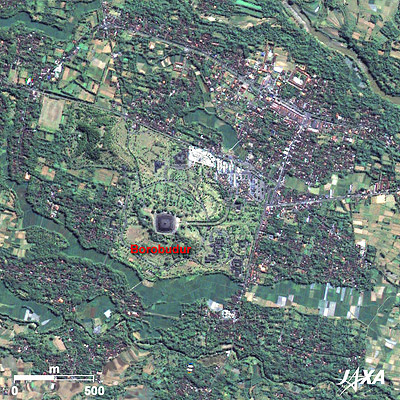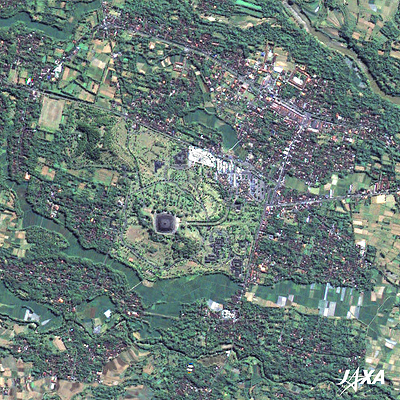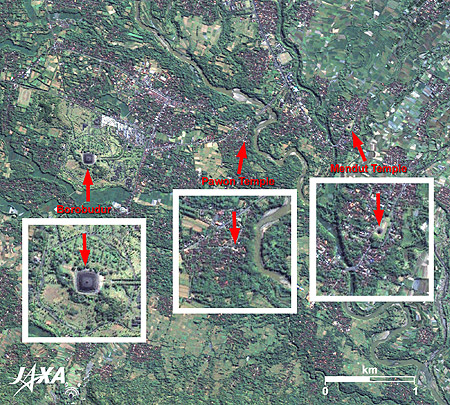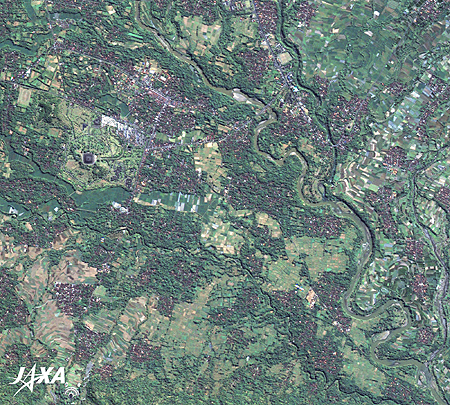

Latest Observation
2010.01.06 Wed
The Ruins of Borobudur: Glory of an Ancient Dynasty
Figure 1 depicts the ruins of Borobudur and its vicinity as observed by ALOS (“Daichi”) in June 2008. Mount Merapi (2,968 m), the most active volcano in Indonesia, is visible at the center of the image. The Ruins of Borobudur were discovered west of the mountain in Central Java. Borobudur is one of the largest Buddhist temples in the world, which is why it was added to the World Heritage list of UNESCO. The splendor of Borobudur ranks with that of Angkor Wat in Cambodia.
caption on
caption off
Borobudur (kmz, 2.07 MB, Low Resolution) as seen on Google Earth
Figure 2 presents an enlarged image of Borobudur. The temple is composed of a square base of 120 meters a side, five concentric square terraces, and three circular platforms overlapping to give it a total height of 35 meters. The image clearly shows the size and structure of the temple.
Borobudur was built using about 2 million stone blocks, each about 20-30 centimeters thick. Although it is called a temple, there is no space inside. It is a soil mound covered with stone blocks.
A bell-shaped “stupa” stands in the center of the top platform. A stupa is a tower where Buddha’s ashes rest and is the origin of the Japanese word “sotoba,” a long wooden tablet that stands in graveyards. Small stupas surround the stupa on the circular platform, each containing a statue of Buddha. In addition, 432 Buddha statues rest in the hollows of the walls of a rectangular platform. The walls are also decorated with reliefs of the Buddhist tale.
Construction of Borobudur
This magnificent temple was built during the eighth and ninth centuries. The Sailendra dynasty ruled this district in that period. It is believed that the Sailendra dynasty embraced Buddhism, which had spread from India, and built Borobudur to make the faith into a form. Construction continued as long as 50 years, although there were some interruptions along the way. A little earlier in Japan, erection of the Great (Image of) Buddha in Todai-ji Temple took place as part of a national project. Although it is an occurrence of seemingly meaningless coincidence, it is an interesting fact that the two constructions, based on a belief in Buddhism, though geographically far apart, took place in the same period.
Soon after the completion of Borobudur, the power of the Sailendra dynasty declined in Java and Buddhism was replaced by Hinduism, which believes in the god Shiva. Borobudur Temple was soon forgotten and it fell into a long slumber under the ground. There are two views on how this happened: one claims that volcanic ashes buried the temple and the other that people buried it in order to avoid destruction by Islam, which had entered into the district.
Nevertheless, this grand temple awoke again in 1814 after its 1,000-year slumber. Thomas S. Ruffels, Lieutenant Governor-General of Java, and H.C. Cornelius, a Dutch engineer, discovered the temple in the jungle and excavation and restoration were performed from the nineteenth century to the twentieth century. Due to the bruising of time, there was danger of collapse, but it was restored by the 10-year UNESCO initiative starting in 1973. Today, it is a place of pilgrimage for Buddhists and a resort visited by many tourists.
Heading east from Borobudur, Pawon Temple and Mendut Temple stand in a line at almost the same distance. These temples are registered to the list of the World Heritage as part of the “Borobudur Temple Compounds.” More Buddhist buildings may have stood there in the past.
Borobudur looks to the heavens from the grand stupa. If we look at the shape of the temple from ALOS in the sky, we are strongly impressed with their religious devotions and the glory of the once prosperous ancient dynasty.
Explanation of the Images:

| Satellite: | Advanced Land Observing Satellite (ALOS) (Daichi) |
| Sensor: |
Advanced Visible and Near Infrared Radiometer-2 (AVNIR-2) and Panchromatic Remote-Sensing Instrument for Stereo Mapping (PRISM) |
| Date: | 0300 (UTC) on June 17, 2008 (Simultaneous observation of AVNIR-2 and PRISM) |
| Ground resolution: | 10 m (AVNIR-2) and 2.5 m (PRISM) |
| Map Projection: | Universal Transversal Mercator (UTM) |
AVNIR-2 has four observation bands. The composite images are usually produced by assigning red to Band 3 (610 to 690 nm), green to Band 2 (520 to 600 nm), and blue to Band 1 (420 to 500 nm). The resulting images have natural coloring as if seen by the naked eye. Thus, the following colors designate ground objects:
| Dark Green: | Forests |
| Light green: | Farmlands or grass fields |
| Light bluish-grey: | City area |
| Brown: | Dry fields |
| White: | Roads, buildings, or clouds |
PRISM is an optical sensor for observing ground surfaces with visible and near-infrared signals in the 520- to 770- nanometer (one-billionth of a meter) band. The acquired image is monochrome. PRISM has three independent optical systems (telescopes) to acquire images for nadir, forward, and backward views at the same time. Only the nadir image was used in this article.
The above AVNIR-2 composite image was then transformed into hue, saturation, and intensity, and the intensity was replaced by the PRISM image. The hue, saturation, and intensity data were then reversed into a color image. As a result, a virtual 2.5-m ground-resolution color image was obtained. This kind of high-resolution color image, composed by combining the higher resolution monochrome image and the lower resolution color image, is called a pan-sharpened image. Figures 2 and 3 are high-resolution, pan-sharpened images composed this way.
A Masterpiece of Khmer Architecture: The Angkor Ruins
ALOS (Daichi) observes Earthquake Stricken Area in Central Java, Indonesia
JERS-1 SAR mosaic covering Insular South-East Asia
Search by Year
Search by Categories
Tags
-
#Earthquake
-
#Land
-
#Satellite Data
-
#Aerosol
-
#Public Health
-
#GCOM-C
-
#Sea
-
#Atmosphere
-
#Ice
-
#Today's Earth
-
#Flood
-
#Water Cycle
-
#AW3D
-
#G-Portal
-
#EarthCARE
-
#Volcano
-
#Agriculture
-
#Himawari
-
#GHG
-
#GPM
-
#GOSAT
-
#Simulation
-
#GCOM-W
-
#Drought
-
#Fire
-
#Forest
-
#Cooperation
-
#Precipitation
-
#Typhoon
-
#DPR
-
#NEXRA
-
#ALOS
-
#GSMaP
-
#Climate Change
-
#Carbon Cycle
-
#API
-
#Humanities Sociology
-
#AMSR
-
#Land Use Land Cover
-
#Environmental issues
-
#Quick Report
Related Resources
Related Tags
Latest Observation Related Articles
-
 Latest Observation 2025.10.01 Wed [Quick Report] Hurricane Humberto “Eye” captured by EarthCARE satellite (Hakuryu)
Latest Observation 2025.10.01 Wed [Quick Report] Hurricane Humberto “Eye” captured by EarthCARE satellite (Hakuryu) -
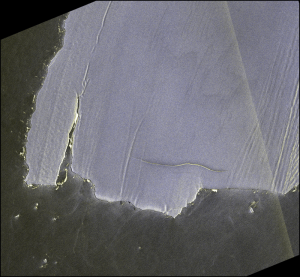 Latest Observation 2025.02.28 Fri The world’s largest iceberg, A23a, may have run aground on the continental shelf of South Georgia:
Latest Observation 2025.02.28 Fri The world’s largest iceberg, A23a, may have run aground on the continental shelf of South Georgia:
The trajectory of iceberg A23a observed by “GCOM-W”, “ALOS-2” and “ALOS-4” -
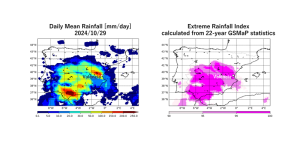 Latest Observation 2024.11.06 Wed [Quick Report] Heavy rainfalls in eastern Spain, as seen by the Global Satellite Mapping of Precipitation (GSMaP)
Latest Observation 2024.11.06 Wed [Quick Report] Heavy rainfalls in eastern Spain, as seen by the Global Satellite Mapping of Precipitation (GSMaP) -
 Latest Observation 2024.10.11 Fri Antarctic Winter Sea Ice Extent Second lowest in Satellite History
Latest Observation 2024.10.11 Fri Antarctic Winter Sea Ice Extent Second lowest in Satellite History










